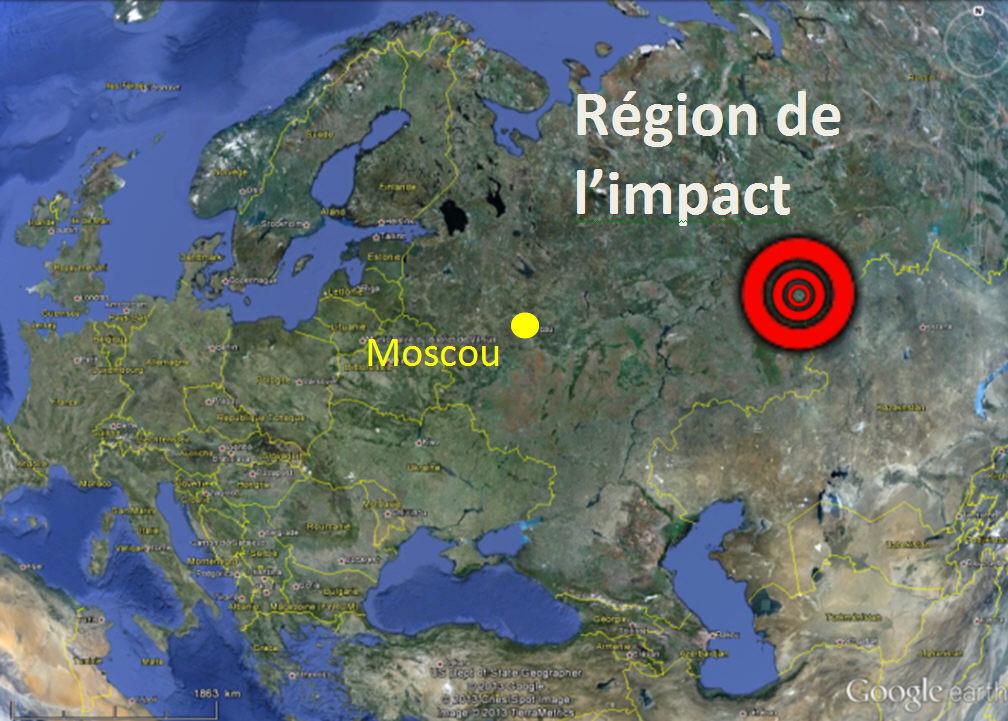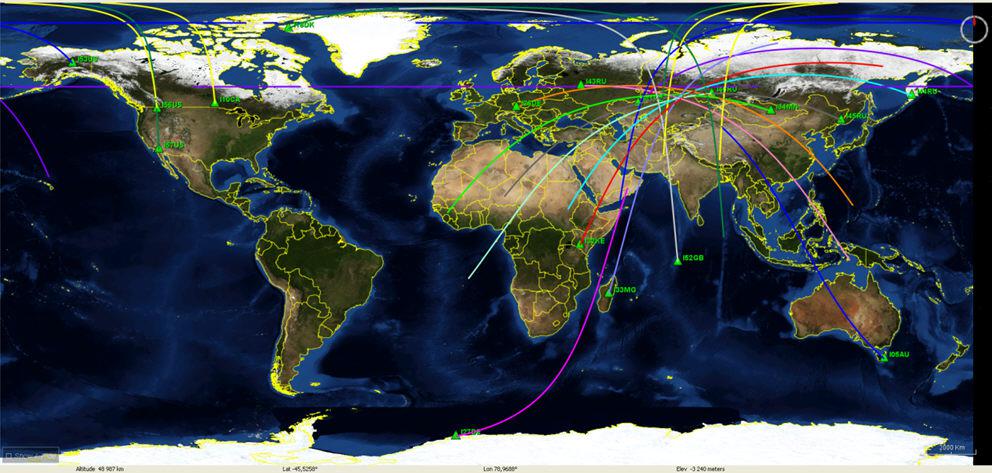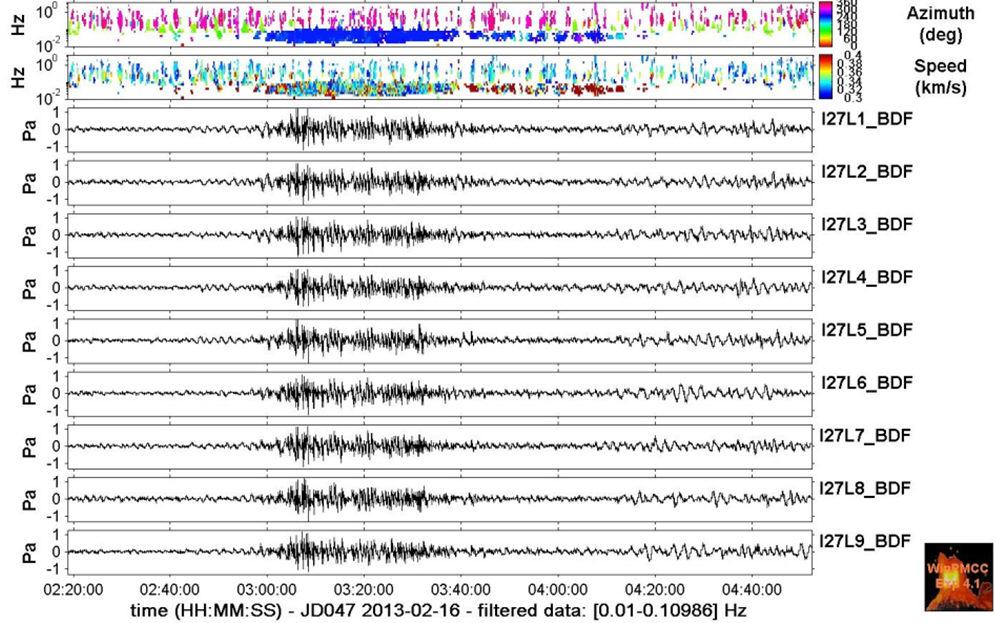 |
 |
 |
 |
 |
 |
 |
 |
Scientifiques files |
 |
 |
| |


|
Disintegration of meteorite on 15/02/2013 near Chelyabinsk in the Urals |
On 15 February 2013 at 03h20 UT, a meteorite disintegrated over the Ural Mountains 1500 km east of Moscow (Figure 1). The shock wave of the explosion injured nearly 1500 people and caused much property damage over a vast area located around the town of Chelyabinsk. Comparable with the explosion of the meteorite over Sulawesi on 8 October 2009, this event is one of most powerful ever recorded by the International Monitoring System (IMS) network of the Comprehensive Nuclear-Test-Ban Treaty Organization (CTBTO). The acoustic waves generated by the explosion were detected by 18 infrasound stations, the most remote (IS27) being located in Antarctica at 15,500 km from the source.

 Figure 1: Location of the region in Russia where the meteorite disintegrated on 15/03/2013 at around 03h20 UT.
Figure 1: Location of the region in Russia where the meteorite disintegrated on 15/03/2013 at around 03h20 UT.
The event was detected by the automatic processing systems of the National Data Centre (NDT) at the DASE, as well as by the International Data Centre (IDC) in Vienna. The interactive processing carried out in the hours following the event made it possible to identify all the infrasound signals associated with the meteorite, and provided results on the location of the source and a preliminary estimate its energy.
 Information on the event
Information on the event
The damage to property (breaking of window panes, collapse of buildings) was noted mainly in the city of Chelyabinsk (55.2°N, 61.4°E), and local amateur videos provide evidence of a meteorite shower at around 03h20 UT resulting from the disintegration of a large celestial object in the atmosphere. The meteorite left a vapour trail in the sky extending over approximately 500 km before disintegrating at an altitude of 23 km (at latitude 54.80°N longitude 61.10°E, corresponding to the point of maximum luminosity, according to a report from the Department of Physics and Astronomy, University of Western Ontario, Canada). The shock wave of the main explosion was accompanied by ten small explosions related to the disintegration of fragments. Although most of the fragments broke up in the atmosphere, some impact craters several metres in diameter were discovered close to Chebarkul and Zlatoust. According to NASA, the object came from the asteroid belt, and measured 17 m with a mass of approximately 10,000 tons. This event would have released a total energy estimated at a few hundred kilotons of TNT.
 Signals detected by the infrasound network
Signals detected by the infrasound network
The event was recorded worldwide by 18 stations of the IMS. Figure 2 presents the projections of the azimuths of signals detected by the stations, which converge towards the region of the Urals where the meteorite disintegrated. The explosion of the meteorite was so powerful that the infrasound wave travelled completely around the world. Indeed , the direct arrival was observed at station IS27 in Antarctica (azimuth 60°, after propagation over a distance of 15,500 km) , while a second arrival was recorded 9 hours later in the opposite direction (azimuth 239°, after propagation along a great circle over a distance of approximately 25,000 km). Such arrivals have not been observed since the last major eruption of Mount Saint Helens in 1980.

 Figure 2: Detection of signals from disintegration of the meteorite on 15/02/2013 recorded by 18 stations of the IMS infrasound network
Figure 2: Detection of signals from disintegration of the meteorite on 15/02/2013 recorded by 18 stations of the IMS infrasound network
Figure 3 shows the arrival of the first waves at station IS27 in the Antarctic. The direction of arrival of the wave front and the group velocities are calculated using the the PMCC method (Progressive Multi-Channel Cross-Correlation). The dominant period of the signals associated with the meteorite lies between 10 and 50 s (azimuth coloured in yellow). Above 0.1 Hz, other permanent signals (in red) are characteristic of the noise generated by ocean swell. Figure 4 shows the second arrival at the same station, but in the opposite direction, which occurs approximately 9 hours later than the the direct arrival.

 Figure 3: Detection of infrasound waves in Antarctica propagated via the shortest great-circle route (approximately 15000 km) in the frequency band 0.01 – 4 Hz.
Figure 3: Detection of infrasound waves in Antarctica propagated via the shortest great-circle route (approximately 15000 km) in the frequency band 0.01 – 4 Hz.

 Figure 4: Detection of infrasound waves in Antarctica propagated via the longest great-circle route (approximately 25,000 km) in the frequency band 0.01 – 4 Hz.
Figure 4: Detection of infrasound waves in Antarctica propagated via the longest great-circle route (approximately 25,000 km) in the frequency band 0.01 – 4 Hz.
 Location of the event and estimate of energy
Location of the event and estimate of energy
The signals obtained from all the infrasound stations were used to reconstruct the the event automatically. Without applying a wind model that would deviate the wave trajectory, the contructed event can be located 360 km south-east of Chelyabinsk. The co-ordinates of this event are 53.96°N and 66.50°E, with an onset time of 03h37 UT. The waves generated by the explosion of the meteorite were propagated over very long distances, and the highly variable atmospheric conditions in both space and time complicated the modeling of propagation. However, the atmospheric conditions on 15/02/2013 show dominant stratospheric winds from west to east near the source. Stations located to the east of the event are thus favorably positioned for the detection of a signal.
During its penetration into the atmosphere at supersonic speed, the meteorite was strongly decelerated and underwent disintegration. Several empirical relations are available for estimating the energy released, using measurements of the amplitude or period of the infrasound signals. The energy produced can be calculated using the relations based on a series of measurements obtained from nuclear explosions at low altitude. The result corresponds to the yield of an explosion in equivalent tons of TNT which would produce the same effects as the shock induced by the penetration of the meteorite into the atmosphere. Application of these formulae provides us with a mean value ranging between 50 and 80 kilotons (for comparison, the Hiroshima bomb had a yield of approximately 15 kt). These estimates are comparable with the energy calculated for the Indonesia meteorite event on 8 October 2009, which also generated signals recorded at distances greater than 15,000 km. However, these values are lower than those published by NASA, which indicate an equivalent yield in excess of 300 kt. Such events are exceptional in terms of the number of stations detecting the signals and the long distances of propagation, and are observed with an average return time of ten years.
|
|
|
